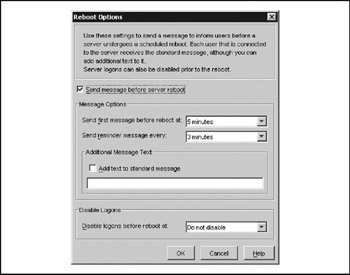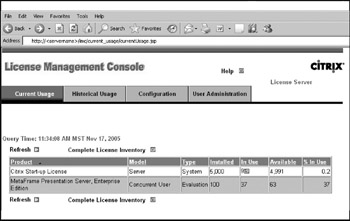SCHEDULED MAINTENANCE ACTIVITIES
| | ||
| | ||
| | ||
There are specific tasks that should be performed at daily, weekly, monthly, and quarterly intervals to ensure service levels are being met. General tasks are outlined in this section to provide a guide for Citrix Presentation Server administrators. It is very important to schedule time at defined intervals to ensure maintenance activities happen and any administrative actions are documented for reference later. Daily issues and maintenance should be tracked and reviewed so that persistent problems can be identified and a timeline can be created for resolving them.
On a quarterly basis, a baseline comparison should be conducted against the information monitored and gathered throughout the period. This will identify any inconsistencies that may need to be addressed. Performing a user load trend analysis will help administrators determine proper use of server resources. If trending indicates degradation of server performance due to overload of users, expansion of the Citrix environment (such as adding additional load-balanced servers) may be necessary. A project, which includes analysis of infrastructure and design, should be initiated and subsequent requisition of hardware, software, and resources scheduled.
Daily Maintenance Activities
Daily maintenance activities are centered on the essential tasks to ensure the Citrix farm is highly available and servicing end-user needs. These tasks should include, but not be limited to, the following:
-
– Back up the data store A Microsoft Accessbased data store (DS) can be backed up either by using the dsmaint backup command utility or by copying the backup data store file (mf20.bak) that is created every time the IMA service is stopped to a network share. This task is most commonly executed daily with a scheduled script. Third-party data stores (SQL or Oracle) require additional configurations from within SQL or Oracle management software to ensure proper backup of the data store. The sample reboot script that follows copies the backup data store file to a network share:
change logon /disable msg * Please log off and save your work. The server is going down in 5 mins. sleep.exe 5 net stop spooler sleep.exe 30 del c:\WINNT\System32\spool\PRINTERS\*.* /q REM ** unremark the next three lines if you are using Microsoft Access as the IMA data store. REM net stop "independent management console" REM sleep.exe 30 REM copy C:\Program Files\Citrix\Independent Management Architecture\mf20.bak \backupserver\share sleep.exe 30 tsshutdn.exe /REBOOT
Note Sleep.exe is part of the Windows 2000 Resource Kit and the Windows Server 2003 Resource Kit.
-
– Reboot servers Servers should be rebooted frequently to eliminate any "hung" processes or memory leaks. A simple reboot script like the one shown above can be used as a scheduled task to reboot servers running Standard, Advanced, or Enterprise Editions of Presentation Server 4. Alternatively, servers running Presentation Server 4 Enterprise have reboot functionality included and can be scheduled from the server properties in the Management Console (MC) for Presentation Server as shown in Figures 20-1 and 20-2.

Figure 20-1: Enterprise Edition reboot scheduling
Figure 20-2: Enterprise Edition reboot optionsCaution Do not reboot more than ten servers every ten minutes. Rebooting more than ten servers at a time can cause severe load on the data store, prompting delays in IMA service start times.
-
– Verify that all servers are communicating properly with the data store This can be done either by running qfarm from the command line with the / app and / load extensions to make sure all servers are showing up and load values are appropriate, or by viewing the status of the server from the CMC. qfarm with the / app switch will detail which servers are providing which applications, checking to make sure all servers and appropriate applications are listed to verify communication. qfarm with the / load switch will detail all servers and their associated load levels. Load levels should be within zero to 9999 at all times. A load level of 10000 indicates a server is reporting maximum load on a particular load evaluator . If the load level is above 10000, it indicates a problem with load balancing or the data store. qfarm used with the / online or / offline switch will display which servers are currently online or offline in the farm.
-
– Perform a thorough review Review any Resource Manager performance alerts, virus notifications, and data store backup logs or scripts for proper execution. Notifications should be configured for these whether they are e-mail or SNMP traps.
-
– Assess event viewer errors Event logs should be checked daily on all servers to ensure that the operating system, applications, and system security are functioning normally. Microsoft Operations Manager is a great utility to view event logs centrally , but other event log consolidation tools exist that can dramatically simplify the daily task of checking each event log by providing a unified interface, such as the products made by RippleTech (see http://www.rippletech.com for more information), Sentry Pro (see http://www.sentry-pro.com for more information), or Gravity Square (see http://www.gravitysquare.com for more information).
-
– Troubleshoot problems Troubleshoot daily user problems and handle emergency hardware issues such as failed hard drives , network cards, and so on.
-
– Check for session states using Management Console (MC) for Presentation Server Reset lengthy disconnected sessions if disconnect times are not enforced. Record and trend the number of disconnected, idle, and active sessions to help refine session disconnect settings.
Weekly Maintenance Activities
Weekly maintenance activities focus on proactive actions that are aimed at keeping both the farm and servers healthy . These tasks should include, but not be limited to, the following:
-
– Verify concurrent user need does not exceed current purchased licensing The
License Management Console (LMC), a new feature in Presentation Server 4, provides one-stop access to all licensing information. Use the LMC to validate numbers and types of license installed and to generate historical reports on license consumption. Access the LMC via a web browser at http://www.< servername >/lmc/index.jsp as shown in Figure 20-3. Note that LMC access is controlled from within the LMC itself and allows the administrator to grant different levels of user access to LMC functions. Look for a low number of available licenses to determine when there is need for additional licensing.

Figure 20-3: Presentation Server License Management Console -
– Check free space Check free space on all servers to ensure sufficient space is available for proper operation. Once a server gets below ten percent of total disk space available, the performance of the server will be affected.
-
– Ensure antivirus definitions are up-to-date Presentation servers typically process the same types of traffic and applications as a desktop PC, and as such are subject to malware. A malware infection on a Presentation server could disrupt service to dozens of users.
-
– Generate reports Create reports on downtime/uptime, performance problems, and lingering issues to understand and react to problems in the environment. Update the user community on current problem resolution and uptime of environment through e-mail, intranet, or other means.
-
– Review and apply any critical Windows, application, or Citrix updates/hotfixes Stay up-to-date with the latest patches or fixes to prevent unnecessary problems. The changes should be applied to a test server first to verify operability before rollout to production servers.
Monthly
Monthly maintenance activities focus on high level farm administration and housekeeping. These tasks should include, but not be limited to, the following:
-
– Monitor bandwidth utilization for ICA sessions Review current bandwidth versus bandwidth needed to support printing, session responsiveness, and potential growth.
-
– Update printer drivers, driver mappings, and remove unused drivers The latest versions of the drivers should be used, all servers should contain the same drivers, unused drivers should be removed, and driver mappings and compatibility lists should be updated. Many problems with print driver inconsistency can be overcome by relying on the Universal Print Driver (UPD).
Quarterly
Quarterly maintenance activities focus on reviewing current farm design and monitoring performance levels. These tasks should include, but not be limited to, the following:
-
– Analyze usage and growth patterns Analyze farm usage and future growth patterns to estimate requirements for expansion of the Presentation Server environment, then perform budgetary and growth planning.
-
– Run defrag and chkdsk on all drives Third-party defragmentation utilities, such as Executive Software's Diskeeper, should be utilized to facilitate scheduled and robust defragmentation.
-
– Perform test restores of the data store from tape backup to an isolated testing environment Since the DS is an important component of the Presentation Server environment, we recommend performing periodic restores from tape backup. This restore should follow established procedures. The DS should be restored onto equipment similar to that in the production environment. To avoid network conflicts and the risk of affecting the production environment, the restored DS should be in an isolated test network (as discussed in Chapter 10). Administrators should check the operability of the restored data store by adding a Presentation Server into the farm and connecting to an application.
-
– Perform baseline comparisons against previous baselines Baseline comparisons indicate whether the current sizing of the farm is adequate. If performance problems are identified, additional hardware and software will need to be purchased and implemented.
EAN: 2147483647
Pages: 137